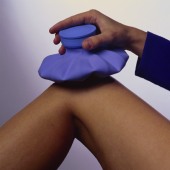
WEDNESDAY, May 26 (HealthDay News) — Osteoarthritis used to be thought of as an older person’s condition.
The joint disease occurs over time as the cartilage between bones breaks down and wears away, allowing the bones to rub together and causing pain, swelling and loss of motion.
“If you live long enough, it’s like death and taxes — you will likely get osteoarthritis,” said Dr. Todd Stitik, an associate professor of physical medicine and rehabilitation at the University of Medicine and Dentistry of New Jersey.
But these days, doctors have been seeing osteoarthritis more frequently in younger people, particularly osteoarthritis of the knee joints. Researchers are trying to figure out why.
The most promising avenues of study have tied early onset knee osteoarthritis to serious knee injuries, such as anterior cruciate ligament (ACL) tears.
One study found that impact-related ligament tears inside the knee can play havoc on the surrounding cartilage cells. Impacts that were hard enough to tear ligaments but not fracture bone or cartilage still caused cartilage cells to die off in a cascade that reached well away from the impact zone.
“If you have injury to the cartilage, that can weaken the cartilage and make it less durable over time,” said the study’s lead author, Dr. Constance R. Chu, an associate professor of orthopedic surgery at the University of Pittsburgh and director of its Cartilage Restoration Center. “What we’re looking at is an impact injury that wasn’t sufficient to fracture the cartilage, but I still would consider it a major impact.”
The damage done to the cartilage cells by that type of injury would be invisible on a typical MRI scan, Chu said. Nonetheless, she guessed that about half of the people who sustain an ACL tear could develop osteoarthritis within five to 10 years. The findings were reported in the December issue of the American Journal of Sports Medicine.
Most early onset osteoarthritis appears to be tied to exercise and sports. People are playing harder at younger ages and potentially doing themselves harm by not protecting their joints.
Another study, this one presented at the 2009 annual meeting of the Radiological Society of North America, found that people engaged in high levels of physical activity sustained more severe knee injuries, including such damage as fluid buildup in bone marrow and lesions on their cartilage and ligaments. Such injuries drastically increase the chances of developing osteoarthritis, according to the researchers.
Stitik cited as an example a college student he treated. She was in her early 20s, had been doing a lot of exercises, such as squats and lunges, that are hard on the knees, and she had been doing them improperly, he said.
“An MRI showed arthritic changes already taking place under her kneecap,” Stitik said. “She was doing exercises improperly and was overdoing it. She was with a personal trainer and also exercising on her own — just doing too much.”
However, Chu suspects there also is a connection between early onset osteoarthritis and the growing obesity epidemic.
“If someone is overweight or obese, they put more stress on cartilage that has been weakened by injury,” she said. “It is chronic overload [and] a very likely cause of osteoarthritis.”
People who injure a knee should approach their recovery with great care if they want to reduce their chances of osteoarthritis, Chu said.
“Give the joint some time to recover,” she said. “How long, we don’t really know — but for sure until any pain or swelling goes away. Then they should gradually return to their activity.”
Active adults can better protect their knees from injury by strengthening their thigh and leg muscles through exercise, Chu said. These muscles provide crucial support to the knee joint. People also should be careful about the amount of high-impact exercise they do and should try to drop some pounds if they are overweight, she said.
“I actually advise my patients that the same types of things we think are good for their heart — regular exercise, eating well — are likely to be the healthiest for their joints as well,” she said. “We can’t control our genetics. Some people are literally born with tougher cartilage. It’s the lifestyle factors that are under people’s control that absolutely factor into whether a joint injury translates into early osteoarthritis. There are things people can do to reduce their chances of having terrible knees at a very, very young age.”
More information
The Arthritis Foundation has more on osteoarthritis.

